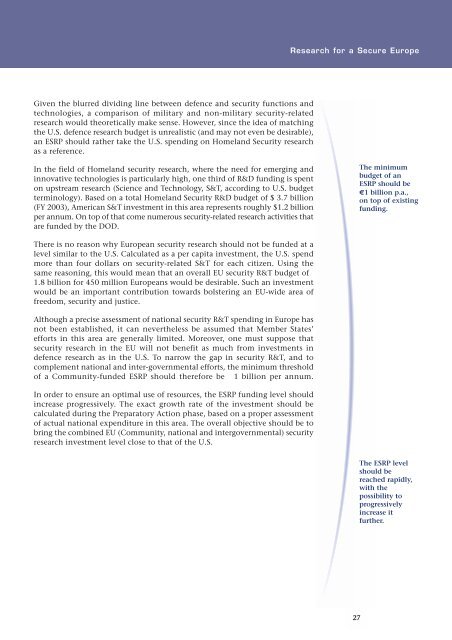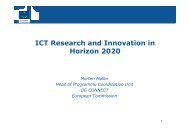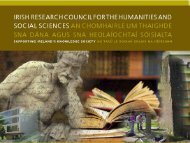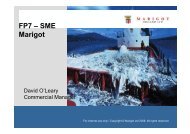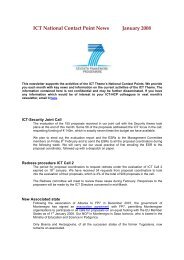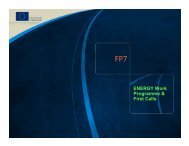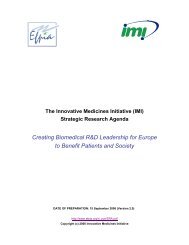Research for a Secure Europe - European Commission - Europa
Research for a Secure Europe - European Commission - Europa
Research for a Secure Europe - European Commission - Europa
Create successful ePaper yourself
Turn your PDF publications into a flip-book with our unique Google optimized e-Paper software.
<strong>Research</strong> <strong>for</strong> a <strong>Secure</strong> <strong>Europe</strong><br />
Given the blurred dividing line between defence and security functions and<br />
technologies, a comparison of military and non-military security-related<br />
research would theoretically make sense. However, since the idea of matching<br />
the U.S. defence research budget is unrealistic (and may not even be desirable),<br />
an ESRP should rather take the U.S. spending on Homeland Security research<br />
as a reference.<br />
In the field of Homeland security research, where the need <strong>for</strong> emerging and<br />
innovative technologies is particularly high, one third of R&D funding is spent<br />
on upstream research (Science and Technology, S&T, according to U.S. budget<br />
terminology). Based on a total Homeland Security R&D budget of $ 3.7 billion<br />
(FY 2003), American S&T investment in this area represents roughly $1.2 billion<br />
per annum. On top of that come numerous security-related research activities that<br />
are funded by the DOD.<br />
The minimum<br />
budget of an<br />
ESRP should be<br />
€1 billion p.a.,<br />
on top of existing<br />
funding.<br />
There is no reason why <strong>Europe</strong>an security research should not be funded at a<br />
level similar to the U.S. Calculated as a per capita investment, the U.S. spend<br />
more than four dollars on security-related S&T <strong>for</strong> each citizen. Using the<br />
same reasoning, this would mean that an overall EU security R&T budget of<br />
1.8 billion <strong>for</strong> 450 million <strong>Europe</strong>ans would be desirable. Such an investment<br />
would be an important contribution towards bolstering an EU-wide area of<br />
freedom, security and justice.<br />
Although a precise assessment of national security R&T spending in <strong>Europe</strong> has<br />
not been established, it can nevertheless be assumed that Member States’<br />
ef<strong>for</strong>ts in this area are generally limited. Moreover, one must suppose that<br />
security research in the EU will not benefit as much from investments in<br />
defence research as in the U.S. To narrow the gap in security R&T, and to<br />
complement national and inter-governmental ef<strong>for</strong>ts, the minimum threshold<br />
of a Community-funded ESRP should there<strong>for</strong>e be 1 billion per annum.<br />
In order to ensure an optimal use of resources, the ESRP funding level should<br />
increase progressively. The exact growth rate of the investment should be<br />
calculated during the Preparatory Action phase, based on a proper assessment<br />
of actual national expenditure in this area. The overall objective should be to<br />
bring the combined EU (Community, national and intergovernmental) security<br />
research investment level close to that of the U.S.<br />
The ESRP level<br />
should be<br />
reached rapidly,<br />
with the<br />
possibility to<br />
progressively<br />
increase it<br />
further.<br />
27


